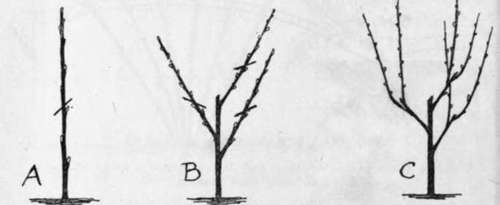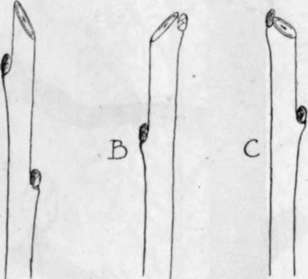Chapter XVII. Apples, Pears, And Plums
Description
This section is from the book "School Gardening", by W. Francis Rankine. Also available from Amazon: School Gardening.
Chapter XVII. Apples, Pears, And Plums
Apples
Bush Apples are the best form of tree for the school fruit plot. They are not out of reach when the scholars are at work, and the principles of management, after the foundation has been laid, are almost identical with those required for standards. As a rule the young trees are purchased already formed, and all that is necessary is close attention to the pruning year by year, so that the compact habit is preserved. A Bush Apple may be formed by heading back a maiden tree one year old (from the bud or graft) so that about three buds remain. The shoots that are thrown from these are cut back the next season and the six or eight resultant shoots form the foundation branches; if these are subsequently pruned so that the growth is led outwards, an open bush is the result. Planting should be done in October, November, or in March, and it is necessary to carry out this operation when the soil is easily worked-it must neither be sodden with wet, dust dry, nor frozen.

Fig. 61. Forming A Bush Apple.
Pruning
By means of pruning, it is possible to concentrate the energy of the tree and at the same time control its form. The use of the knife or secateurs is essential, and the methods of using these tools are of the greatest importance. Pruning cannot be successfully carried out without careful consideration on the part of the cultivator of the habits of the tree to be treated. Generally, Apples and Pears present little difficulty in this respect. In the case of Apples, the fruit is usually borne on spurs on the old wood, yet there are instances in which the fruit appears on the extremities of the young wood, and consequently in such cases the new growths must not be pruned in the following winter, but these examples are exceptional. The aim in pruning Apples must be to remove young growths, and this must be done in such a way that exuberant wood is removed in order to open the tree fully to the influences of sunlight and air. In the case of Bush Apples grown on the school plot, extension growth must be carefully controlled, and the pruning knife must be run over the trees in the spring following the autumn of planting. The branches should be cut back to a wood bud, so that about two-thirds of their length remains, and the cut must be made to a bud which points outwards-this ensures that the centre of the tree is not choked by consequent growths.

Fig. 62. Pruning Cuts.
A.-Bad cut leaving a snag. B.- Good cut. C.-Bad cut injuring bud.
In the case of trees making excessively luxuriant growth lifting and replanting must be had recourse to, and at the same time the roots should be pruned with a very sharp knife.
Continue to:
- prev: Strawberries
- Table of Contents
- next: Pears
